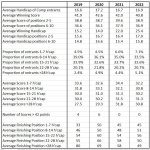Bdill93
Undisputed King of FOMO
Yup I gotta agree with you, something does not add up at your place
I just checked another course here I played last weekend again with HI of 15.6 at a course rated 70.1/127 and had to play off 16 course handicap off tees measuring 6,300 yards and tough enough to be used as a European tour venue
It simply doesn't make sense that I can come to your place and be given an extra shot with a CH of 17 at fully 800 yards shorter and by all accounts an easier course
Exactly! And thats why we keep seeing points of 40+
If the slope/ CR or whatever it is that needs changing was genuine, players should be playing off or below their HI at my club for sure.
I can promise you now, at Hayling in a couple of weeks off a HI of 12.4 I will be lucky for 20+ points

